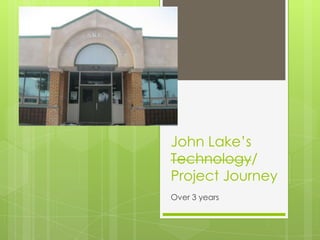
John Lake's 3-year technology project journey
- 1. John Lake’s Technology/ Project Journey Over 3 years
- 3. Points to Consider around Technology There are 3 Orders of Change First Order Change – LITERACY - Efforts, Doing, Optional, Volunteerism, Quantitative This is the WHATEVER phase – do anything, just DO something! Consider: If we had something, what would we have? If we did have stuff, what would we measure?
- 4. Second Order Change ADAPTING Second order Change – Results geared, Learning Targets evident, Pervasive, Everyone GOES!! Projects are connected to learning but with broad goals
- 5. Are we doing the same thing but with a different tool??
- 7. Third Order Change TRANSFORMING Third order – Hard to achieve, and MUST be data driven Technology is INTEGRATED across the curriculum What level do you feel you are at? What level is your current staff at? What could you do in your current position to help others move forward?
- 8. Technology is only technology if it is new….
- 9. The ‘smart’ kids today are the ones that are able to sift/process information quickly and make meaning from it - - not the kids that can repeat it
- 10. What to Consider When Forming Essential Questions to Drive Inquiry Based Projects? Need to create specific, measurable outcomes from curriculum around LEARNING Consider: What do you want the student to be able to do/show you? Are you creating efforts goals or results goals? What would you measure? Are you counting the doings or considering the RESULT of the doing?
- 11. Key Ideas Remember the HEAT (Higher order thinking, Engaged Students, Authentic Tasks, Technology Uses) Must be outcome driven We need to ask ourselves what we expect students to learn/show us/be able to do from these outcomes Always consider LAT (LITERACY, ADAPTING AND TRANSFORMING) and how it relates to HEAT
- 13. Four Main Goal Categories Technology Efforts (counting the doings) Techology Results (what’s going to happen) Learning Efforts Learning Results KEYWORDS: LEARNING and STUDENTS
- 14. Trend - 2010 Our goals around technology (in our system) – 80% tech efforts, 10% tech results, 10% learning efforts Shift towards – 67% Learning Results – 19% Tech Efforts, 14% Tech results Where is your levels at? What about your school/staff?
- 15. Multiple Intelligences Premise: All students can learn and achieve outcomes - - just may need a different path and TECHNOLOGY can assist with that DI – Differentiated Instruction The person doing the most is learning the most
- 17. Challenges Allstaff on board and open to change Survey of self and classroom needs Wish lists TIME Technology not working Difficulties with support
- 18. Direction Learning Driven goals/outcomes - - choose to have our students be meaning makers THEN media makers Students are Producers not simply consumers
- 19. Consider… Everyone is at a different starting point - - honour that point and do our best to support them to move to next level Take their strengths and move forward with those in mind Everyone completes one project (minimum) that has a strong essential question driving work
- 20. Wallwisher, Permissions, pirate pad, best place todays meet, to show, is anchor charts, the learning Inspiration, shown, bubble.us blogs Databases, advanced search, digital footprint, copyright, skype, various cited sources Feedback tools (pmi chart), self- assessments, checklists Word, google docs, Spellchecker, word storyboards, tools, check ins, organizers feedback
- 21. Projects Weather around the world Healthy Living, Good choices PSA’s Book Trailers Digital Stories Infographics Puppet projects Counting Books **The project is transformational/ technology is useful l if something is being created/displayed that CAN’T be done otherwise**
- 22. Tools used to reach outcomes in Projects PSA’s – i-movie, windows movie maker, animoto Infographics - Explaining thinking – audacity, educreations, podcasts, videos Explaining learning – slideshare, prezi, comic life, glogster Today’s Meets, wallwisher, organizers Various online tools (bubble.us) MANY MORE
- 23. Blogs http://elementarylibguides.spsd.sk.ca/johnlake Grade K-2 – Main Page – Theresa Dolgopol’s blog Grade 6-8 – Main Page – Mitch Lowe’s Blog
- 24. Biggest challenges: Choosing best tool for the purpose Feeling comfortable to open projects up for students to use more than one tool TIME
- 25. Next Steps - Discoveries We get tired of using technology - - balance needed Continue to focus on covering outcomes with technology integrated Explore best uses of our technology Collaborate more with other groups outside of our school/board BLOGS (wider audience)
- 26. You never know how far you’ve travelled until you stop, turn around, and take a look back.
